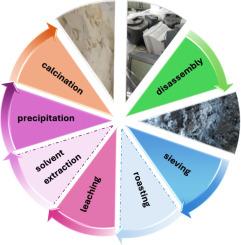从阴极射线管荧光粉中回收Y和Eu的研究综述
IF 10.9
1区 环境科学与生态学
Q1 ENGINEERING, ENVIRONMENTAL
引用次数: 0
摘要
荧光粉是灯和监视器的重要组成部分,也是稀土元素(REE)钇和铕的主要使用者。随着更高效的技术的出现,阴极射线管(crt)在显示器中的使用正在全球范围内下降。因此,这类电子垃圾未经处理就堆积在回收公司和仓库里。本文首先概述了用于收集阴极射线管荧光粉的拆解技术。接下来,讨论了从CRT荧光粉中获得的Y和Eu混合物的回收过程,特别关注基础化学。在开发的浸出方法中,有些包括高温预处理,尽管大多数方法很少提高稀土的回收率或选择性。从浸出液中提取稀土元素的分离方法文献并不多。然而,一些使用磷萃取剂的研究表明,它们可以有效地产生富含稀土元素的溶液,污染最小,因此将受到更多的关注。随后通常采用化学沉淀法分离富含稀土元素的产品,在第一步分离中作为一种成本较低的方法获得纯度较低的稀土氧化物。放大所需的过程优化在大多数处理阶段都缺失,应该得到研究界的更多关注。此外,可持续的回收途径是稀缺的,应该在未来探索,以提高可持续性。本文章由计算机程序翻译,如有差异,请以英文原文为准。

A comprehensive review on Y and Eu recovery from cathode-ray tube phosphors
Phosphors are essential components in lamps and monitors and major users of rare earths elements (REE) yttrium and europium. The use of cathode-ray tubes (CRTs) in monitors is declining worldwide as more efficient technologies emerge. Consequently, this sort of electronic waste accumulates untreated in recycling companies and warehouses. This review first provides an overview of the dismantling techniques used to collect CRT phosphors. Next, recycling processes of Y and Eu mixtures obtained from CRT phosphors are addressed, with particular focus on fundamental chemistry. Among the leaching approaches developed, some include high temperature pre-treatment, although most rarely improve REE recovery or selectivity. Separation approaches addressing REEs retrieving from leach liquors are not abundant in literature. However, some contributions employing phosphorated extracting agents revealed to efficiently produce REE-rich solutions with minimal contamination and will therefore receive more attention. Chemical precipitation is often applied thereafter to isolate REE-rich products, used as a less expensive method to obtain a less pure REE oxide in a first isolation step. Process optimisation, required for scale-up, is missing in most processing stages, and should deserve more attention from the research community. Also, sustainable recycling routes are scarce and should be explored in the future to improve sustainability.
求助全文
通过发布文献求助,成功后即可免费获取论文全文。
去求助
来源期刊

Resources Conservation and Recycling
环境科学-工程:环境
CiteScore
22.90
自引率
6.10%
发文量
625
审稿时长
23 days
期刊介绍:
The journal Resources, Conservation & Recycling welcomes contributions from research, which consider sustainable management and conservation of resources. The journal prioritizes understanding the transformation processes crucial for transitioning toward more sustainable production and consumption systems. It highlights technological, economic, institutional, and policy aspects related to specific resource management practices such as conservation, recycling, and resource substitution, as well as broader strategies like improving resource productivity and restructuring production and consumption patterns.
Contributions may address regional, national, or international scales and can range from individual resources or technologies to entire sectors or systems. Authors are encouraged to explore scientific and methodological issues alongside practical, environmental, and economic implications. However, manuscripts focusing solely on laboratory experiments without discussing their broader implications will not be considered for publication in the journal.
 求助内容:
求助内容: 应助结果提醒方式:
应助结果提醒方式:


